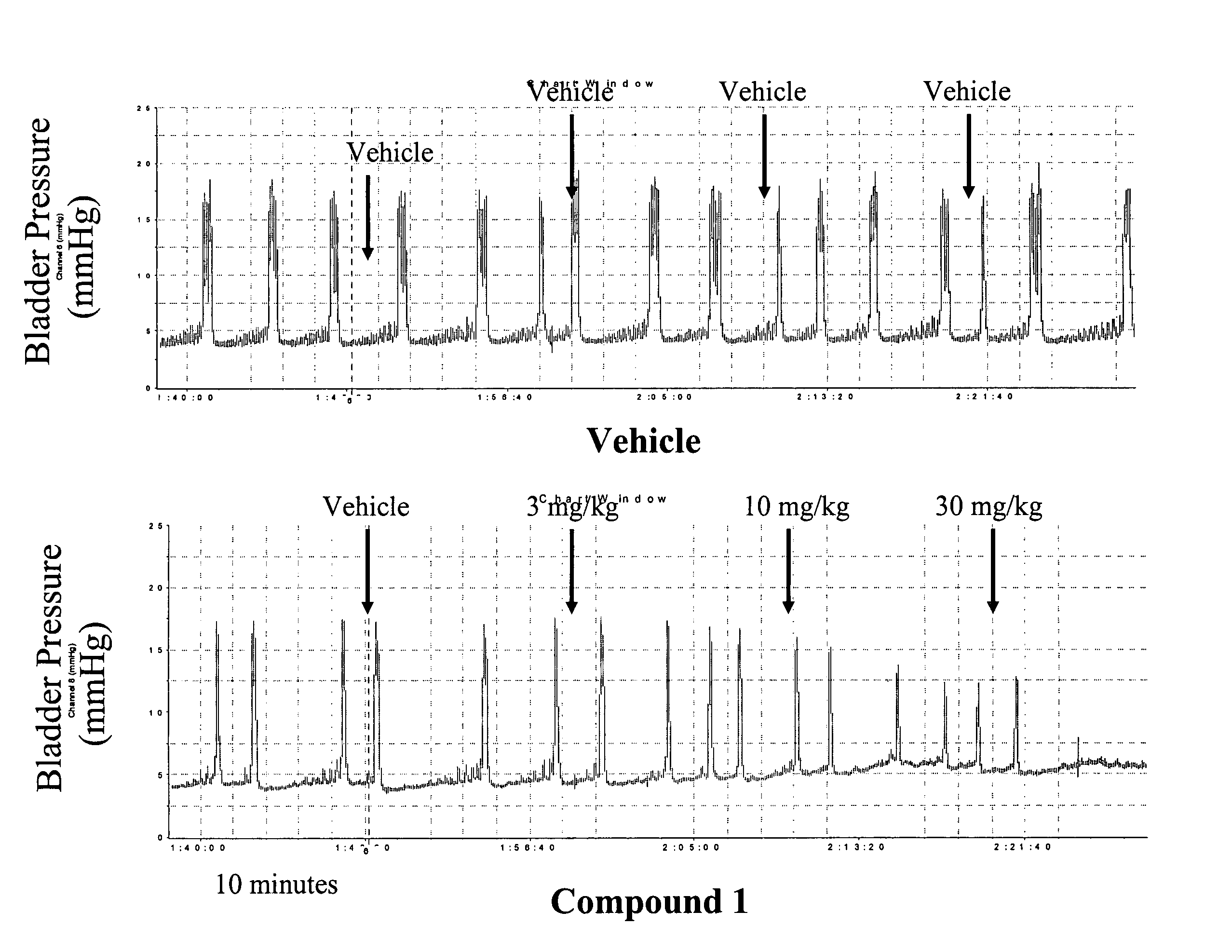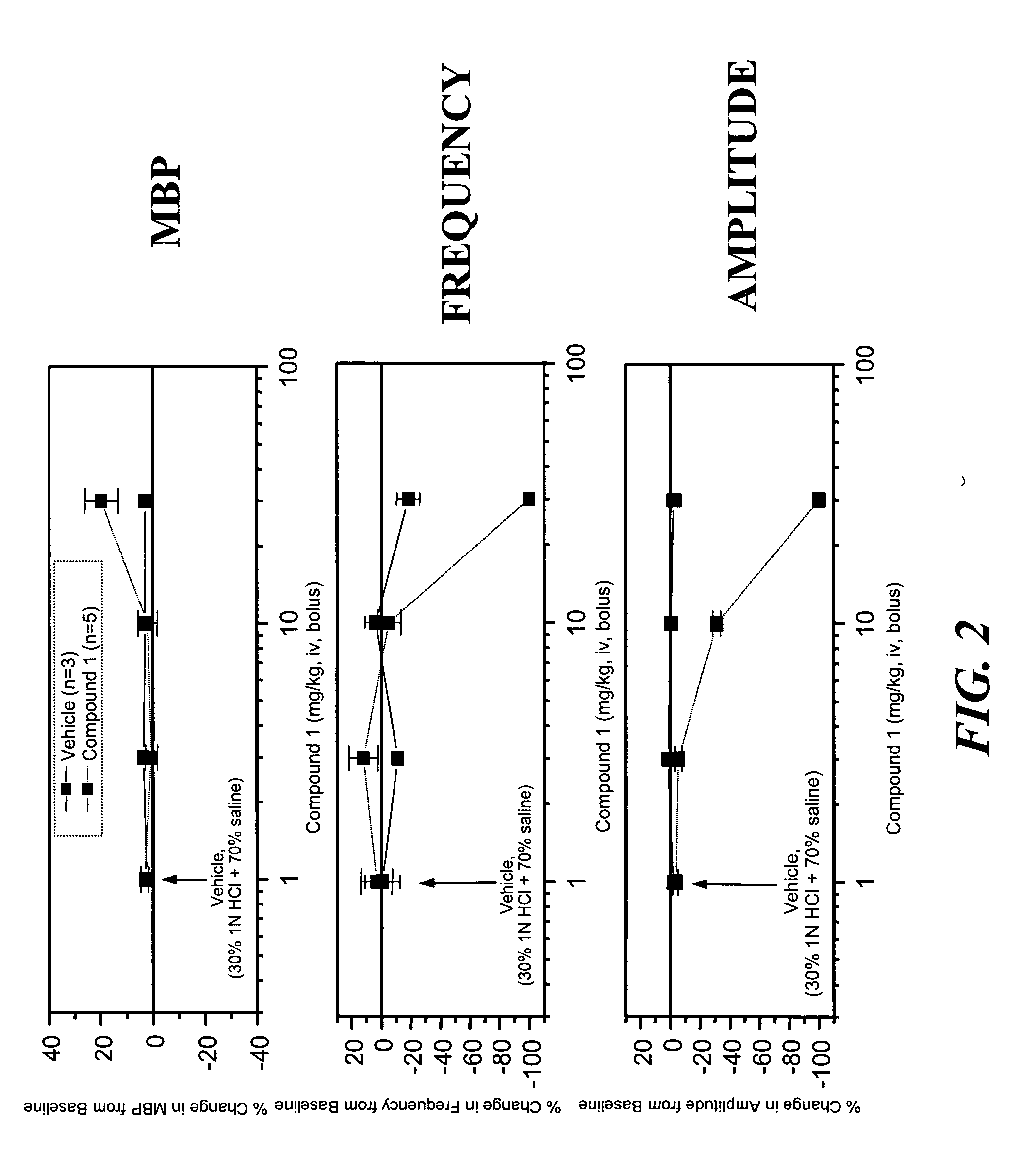Methods of treating genitourinary disorders using inhibitors of soluble epoxide hydrolase
a technology of soluble epoxide hydrolase and genitourinary disorders, which is applied in the direction of elcosanoid active ingredients, instruments, drug compositions, etc., can solve the problems of lack of compelling evidence, inability to use seh inhibitors, and inability to achieve compelling evidence, so as to reduce the frequency and amplitude of bladder contraction.
- Summary
- Abstract
- Description
- Claims
- Application Information
AI Technical Summary
Problems solved by technology
Method used
Image
Examples
example 1
Gene Expression Profiling of Spontaneously Hypertensive Rat Bladders
[0052]Affymetrix GeneChip profiling was performed on the whole bladders of 6 Spontaneously Hypertensive Rats (SHR) and 6 Wistar-Kyoto Rats (WKY). Differential gene expression between SHR and WKY rat bladders were analyzed with the intent to identify potential genes of interest for overactive bladder (OAB).
[0053]Total RNA was isolated from whole bladders using the Trizol method. The isolated total RNA was quantitated by spectrophotometric readings at O.D. 260 and qualified by agarose gel electrophoresis and the Agilent BioAnalyzer RNA 6000 Assay.
[0054]First strand and second strand cDNA was generated from 10 μg total RNA using AMV reverse transcriptase and the “cDNA Synthesis System” kit components from Roche Applied Science (cat #1117831). To generate the cDNA, an oligo dT (24mer)-T7 primer was used to prime the mRNA for the first strand synthesis. After the second strand cDNA synthesis step, the sample was phenol / c...
example 2
TaqMan Real-Time Quantitative Reverse Transcriptase (qRT)-PCR
[0058]RNA was prepared from rat bladders as in Example 1 and stored at −80 C until experiments were performed. Real-time quantitative polymerase chain reaction (RT-PCR) analysis (Heid et al., Genome Res. 6, 986-994 (1996)) was used to determine the relative levels of rat and human soluble epoxide hydrolase from total RNA. Prior to amplification, the total RNA samples were DNAse I treated and purified using Qiagen's “Rneasy Mini Kit” according to the manufacturer's instructions (cat. #74104, Qiagen Inc., Valencia, U.S.A.). Reverse transcription and PCR reactions were performed using “One-Step RT-PCR Master Mix Reagents” according to the manufacturer's instructions (cat. #4309169, Applied Biosystems, Foster City, U.S.A.). Rat and human soluble epoxide hydrolase sequence-specific amplification was detected with an increasing fluorescent signal of FAM reporter dye during the amplification cycle. Each sequence specific amplific...
example 3
Synthesis and Determination of IC50 for Compound 1
[0059]Compound 1, (N-[4-(5-ethyl-3-pyridin-3-yl-pyrazol-1-yl)-phenyl]-nicotinamide),
was synthesized as described (WO 00 / 23060, compound 1). The IC50 was determined with the colorimetric substrate 4-nitrophenyl-(2S,3S)-2,3-epoxy-3 phenylpropyl carbonate as substrate as described by Dietze et al Anal. Biochem. 216, 176-187 (1994)). The IC50 was found to be 0.084+ / −0.002 micromolar when assayed with 100 nanomolar human soluble epoxide hydrolase expressed (Beetham et al. Arch. Biochem. Biophys. 305, 197-201 (1993)) and purified as described by Wixtrom et al. (Anal. Biochem. 169, 71-80 (1994)) at 40 micromolar substrate concentration and 30° C.
PUM
| Property | Measurement | Unit |
|---|---|---|
| volume | aaaaa | aaaaa |
| resting weight | aaaaa | aaaaa |
| surface area | aaaaa | aaaaa |
Abstract
Description
Claims
Application Information
 Login to View More
Login to View More - R&D
- Intellectual Property
- Life Sciences
- Materials
- Tech Scout
- Unparalleled Data Quality
- Higher Quality Content
- 60% Fewer Hallucinations
Browse by: Latest US Patents, China's latest patents, Technical Efficacy Thesaurus, Application Domain, Technology Topic, Popular Technical Reports.
© 2025 PatSnap. All rights reserved.Legal|Privacy policy|Modern Slavery Act Transparency Statement|Sitemap|About US| Contact US: help@patsnap.com



